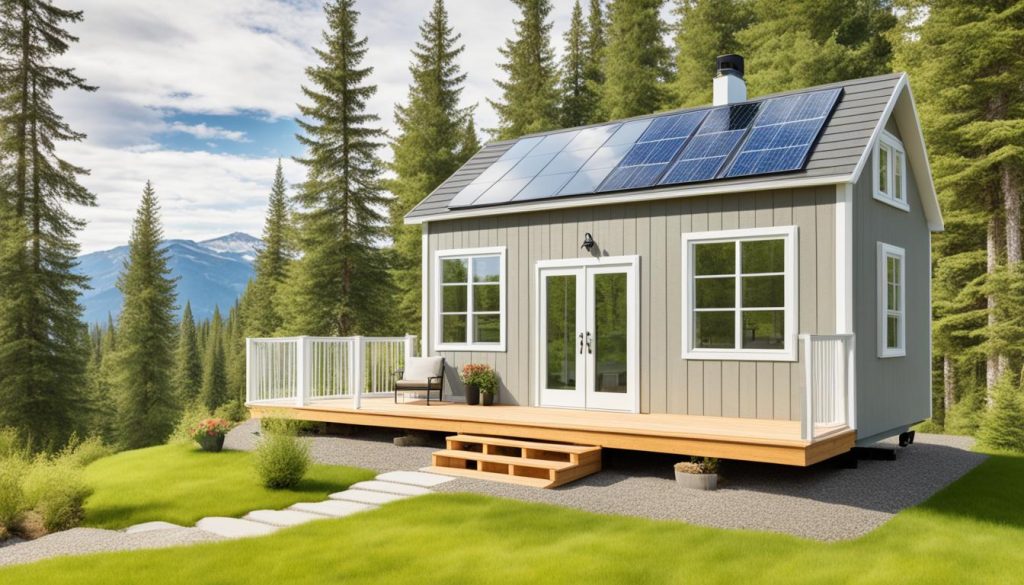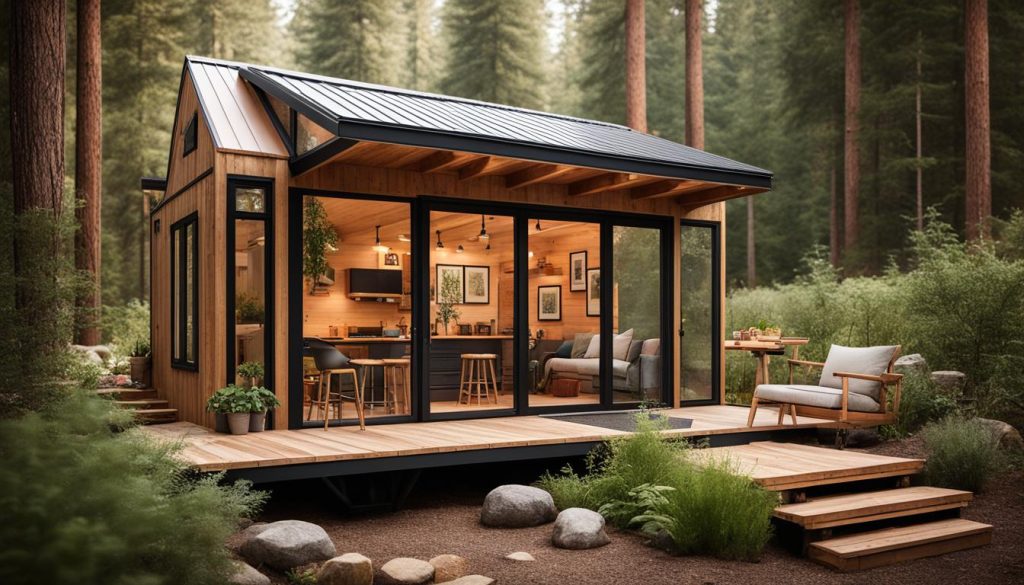Did you know that the average size of a tiny home in Canada typically ranges from 120 square feet to 400 square feet? That’s right, these compact living spaces may be small in size, but they are designed to include all the necessary amenities found in larger homes.
Despite their petite dimensions, tiny homes feature kitchens, bathrooms, living rooms, and bedrooms. Some even go above and beyond with additional features like laundry machines, fireplaces, and dishwashers. Whether on wheels or built on foundations, tiny homes offer an ingenious solution for those seeking simplicity, affordability, and sustainability.
Key Takeaways:
- The average size of a tiny home in Canada ranges from 120 to 400 square feet.
- Tiny homes are designed to include all essential amenities found in larger homes.
- Some tiny homes even have additional features like laundry machines, fireplaces, and dishwashers.
- Tiny homes offer a compact living solution without sacrificing functionality.
- Living in a tiny home promotes simplicity, affordability, and sustainability.
The Various Types and Designs of Tiny Homes in Canada
Tiny homes in Canada offer a range of design options that cater to diverse preferences and needs. Whether you’re interested in mobility or a permanent dwelling, there are various types and designs to choose from.
Tiny Homes on Wheels
Tiny homes on wheels are built on trailers, allowing for easy transportation and flexibility. These portable homes come in different sizes, styles, and layouts, offering homeowners the freedom to change their location whenever desired. Whether you’re looking for a minimalist living space or a fully-equipped tiny house, options are available to suit your needs and preferences.
Small Homes on Foundations
For those seeking a more permanent tiny home solution, small homes on foundations offer stability and longevity. These homes are built on a solid foundation, similar to traditional houses, and can range in style from contemporary to rustic. Small homes on foundations provide more space compared to tiny homes on wheels, allowing for comfortable living while still embracing the tiny lifestyle.
Micro-Houses
Micro-houses go beyond the traditional tiny house size and offer more generous living spaces. Ranging from 700 to 1100 square feet, these homes are ideal for individuals or couples looking for a bit more room while still maintaining the benefits of a small home. With smart design and innovative space utilization, micro-houses provide a balance between compact living and comfort.
High Rise Tiny Houses
High rise tiny houses are a unique option that combines the concept of tiny living with vertical design. Shaped like cubes or vertical rectangles, these high-rise homes are often used as cottages and short-term rentals. They maximize the use of vertical space to provide compact yet stylish accommodation with a small footprint.
Container Homes
Container homes are gaining popularity in Canada due to their affordability and sustainability. These homes are constructed using repurposed shipping containers, offering an eco-friendly and cost-effective housing solution. Container homes can be customized to meet individual needs and can range from minimalist designs to more intricate and spacious layouts.
Yurts
Yurts are circular structures made of wood and fabric, providing a unique and cozy living experience. These easily portable dwellings have been used for centuries by nomadic cultures. Yurts are gaining popularity as small, sustainable homes due to their simplicity, low environmental impact, and versatility. They can be customized with various amenities to provide a comfortable living space.
School Bus Conversions
School bus conversions involve transforming retired school buses into livable spaces. These conversions allow for creative design solutions and can provide a comfortable and compact home on wheels. With clever space utilization and customization options, school bus conversions offer a unique tiny home experience.
Camper Van Conversions
Camper van conversions are another popular option for compact living. By transforming vans into livable spaces, individuals can embrace the freedom of a mobile home with all the necessary amenities. Camper van conversions offer versatility and ease of travel, allowing homeowners to explore different locations while enjoying the comforts of a tiny home.
With such a diverse range of designs available, homeowners in Canada can find the perfect tiny home to suit their lifestyle and needs.
The Costs and Budgeting Considerations of Tiny Homes
When considering the costs of a tiny home in Canada, several factors come into play, including the type of construction, materials used, and size. Understanding these factors will help you determine the budget needed for your tiny home project.
Tiny Home Prices
The price range for tiny homes can vary greatly depending on the level of customization and craftsmanship. Here is a breakdown of the typical price ranges:
| Type | Price Range |
|---|---|
| Basic Model Tiny Home on Wheels | $8,000 – $44,000 |
| Mid-Range Model Tiny Home on Wheels | $45,000 – $79,000 |
| High-End Model Tiny Home on Wheels | $80,000 and above |
| Shipping Container Home | Average $65,000 |
| Micro-House | $38,000 – $160,000 (Average $76,000) |
| High Rise Tiny House | Under $50,000 |
| Mobile Home | $10,000 – $700,000 (Most buyers spend $100,000 – $200,000) |
It’s important to note that these prices are only estimates and can vary based on additional features, finishes, and location.
Cost of Materials and Labor
The cost of materials and labor can significantly impact the overall cost of a tiny home project. Factors such as the type of materials used (e.g., reclaimed wood, eco-friendly insulation) and the complexity of the design can influence the costs. Additionally, the cost of labor can vary depending on the builder’s experience and location.
Considerations for Budgeting
When budgeting for your tiny home project, it’s essential to consider not only the upfront costs but also the ongoing expenses. These may include land or parking fees, utilities, maintenance, and potential upgrades or renovations in the future.

By carefully evaluating your budget and prioritizing your needs, you can make informed decisions about the type of tiny home that fits your financial capabilities and lifestyle preferences.
Living in a Tiny Home: Lifestyle and Considerations
If you’re considering the move to tiny home living, it’s important to understand the unique lifestyle and considerations that come with it. Living in a tiny home goes beyond just downsizing; it requires a deliberate choice to embrace a minimalist lifestyle and make the most of limited space.
One of the benefits of tiny homes is their ability to promote simple living. With limited square footage, you’re encouraged to declutter and prioritize the possessions that truly add value to your life. Every item in a tiny home must serve a purpose and contribute to the overall functionality of the space.
Space utilization is key when it comes to tiny homes. Every nook and cranny is valuable real estate, and maximizing storage options becomes essential. From hidden storage compartments to collapsible furniture, there are numerous creative solutions to make the most of your compact living space.
When it comes to maintenance, tiny homes are easier to clean and care for compared to traditional homes. With less square footage to cover, cleaning becomes quicker and more efficient. However, regular cleaning and organization are crucial to prevent clutter buildup in the limited space.
Creative customization is a major aspect of tiny home living. Despite the small space, there are endless possibilities for personalizing your tiny home to suit your needs and lifestyle. From customized storage solutions to unique interior designs, tiny home owners find joy in making their small space feel like home.
Furthermore, becoming part of a tiny home community can provide invaluable support and resources. Engaging with fellow tiny home enthusiasts allows for sharing ideas, experiences, and advice. You can join online forums, attend meetups, or even live in dedicated tiny home communities to connect with like-minded individuals.
However, it’s important to be aware of the local regulations and zoning laws regarding tiny homes. Each municipality may have its own restrictions and guidelines that govern where and how tiny homes can be placed. Ensuring compliance with these regulations is essential to avoid any legal issues.
Tiny Home Regulations in Canada
| Province | Minimum Square Footage Requirement | Permit Required | Additional Regulations |
|---|---|---|---|
| British Columbia | Not specified | Yes | Tiny home must comply with BC Building Code requirements |
| Alberta | Not specified | No | No additional regulations on tiny homes on private property |
| Saskatchewan | Not specified | No | No additional regulations on tiny homes on private property |
| Manitoba | Not specified | No | No additional regulations on tiny homes on private property |
| Ontario | Not specified | No | No additional regulations on tiny homes on private property |
| Quebec | Not specified | No | Tiny homes classified as RVs have different regulations for use |
| New Brunswick | 120 sq ft | No | Must comply with local building codes |
| Nova Scotia | Not specified | Yes | Must comply with local building codes |
| Prince Edward Island | Not specified | Yes | Must comply with local building codes |
| Newfoundland and Labrador | Not specified | Yes | Must comply with local building codes |
Table: Tiny Home Regulations in Canada
While specific regulations regarding the construction and placement of tiny homes can vary across Canada, it’s important to research and understand the rules in your specific province. Some provinces may require permits or compliance with building codes, while others have no additional regulations for tiny homes on private property.

Tiny Home Trends and the Future of Compact Living
The popularity of tiny homes has surged in Canada as a practical and affordable housing solution amidst rising house prices. These compact dwellings provide an opportunity for individuals to attain homeownership at a lower cost, making them increasingly appealing in today’s challenging real estate market.
Living in a tiny home not only offers cost-saving benefits, but it also encourages a minimalist lifestyle, promoting sustainable living and reducing one’s carbon footprint. With limited space, individuals are motivated to embrace simplicity and prioritize the essentials, shedding unnecessary material possessions.
As the tiny home movement continues to gain traction, more municipalities are accepting and accommodating these small dwellings. This acceptance paves the way for innovative designs and increased accessibility to tiny home communities. The future of compact living in Canada looks promising, driven by the growing demand for sustainable and affordable housing solutions.
With a rising awareness of the environmental impact of traditional homes and the need for affordable housing, the tiny home trend is expected to thrive. As people seek alternative options that align with their values, tiny homes provide an appealing solution that champions sustainability, community living, and financial freedom.

Leave a Reply
You must be logged in to post a comment.